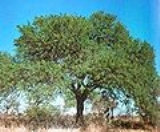
Prosopis nigra
Encyclopedia
- For other tree species with similar names, see AlgarroboAlgarroboAlgarrobo may refer to:* The European carob tree * South American trees of the genus Prosopis* On Cuba, the Albizia saman tree * Algarrobo, Chile, a city in Chile* Algarrobo, Magdalena a town in Colombia...
.
Prosopis nigra (synonym Prosopis algarrobilla) is a South America
South America
South America is a continent situated in the Western Hemisphere, mostly in the Southern Hemisphere, with a relatively small portion in the Northern Hemisphere. The continent is also considered a subcontinent of the Americas. It is bordered on the west by the Pacific Ocean and on the north and east...
n leguminous tree species that inhabits the Gran Chaco
Gran Chaco
The Gran Chaco is a sparsely populated, hot and semi-arid lowland region of the Río de la Plata basin, divided among eastern Bolivia, Paraguay, northern Argentina and a portion of the Brazilian states of Mato Grosso and Mato Grosso do Sul, where it is connected with the Pantanal region...
ecoregion (in particular, the transition zone between the Wet Chaco and the Southern Chaco), in Argentina
Argentina
Argentina , officially the Argentine Republic , is the second largest country in South America by land area, after Brazil. It is constituted as a federation of 23 provinces and an autonomous city, Buenos Aires...
and Paraguay
Paraguay
Paraguay , officially the Republic of Paraguay , is a landlocked country in South America. It is bordered by Argentina to the south and southwest, Brazil to the east and northeast, and Bolivia to the northwest. Paraguay lies on both banks of the Paraguay River, which runs through the center of the...
. It is known as algarrobo negro in Spanish
Spanish language
Spanish , also known as Castilian , is a Romance language in the Ibero-Romance group that evolved from several languages and dialects in central-northern Iberia around the 9th century and gradually spread with the expansion of the Kingdom of Castile into central and southern Iberia during the...
, which means "black carob tree" (the Spanish settlers gave it that name, as they did with many other species of genus Prosopis
Prosopis
Prosopis is a genus of flowering plants in the pea family, Fabaceae. It contains around 45 species of spiny trees and shrubs found in subtropical and tropical regions of the Americas, Africa, Western Asia, and South Asia. They often thrive in arid soil and are resistant to drought, on occasion...
, because of its similarity to the European carob tree
Carob tree
Ceratonia siliqua, commonly known as the Carob tree and St John's-bread, is a species of flowering evergreen shrub or tree in the pea family, Fabaceae...
). It is also variously called algarrobo dulce, algarrobo morado and algarrobo amarillo ("sweet", "purple" and "yellow" carob tree, respectively).
The tree blossoms in September and October, and gives fruit from November to March. It grows together with the vinalillo tree (Prosopis vinalillo) and under the tops of the palm tree Copernicia alba. Like the other species of this genus, it tolerates arid climate, but can also survive in flooded ground for a long time. The heartwood is dark brown and very heavy, considered noble by local carpenters, also weather resistant, it presents streaks.
Usage
Algarrobo negro wood is used in making furniture and barrels. High in tanninTannin
A tannin is an astringent, bitter plant polyphenolic compound that binds to and precipitates proteins and various other organic compounds including amino acids and alkaloids.The term tannin refers to the use of...
, it has been employed for leather tanning
Tanning
Tanning is the making of leather from the skins of animals which does not easily decompose. Traditionally, tanning used tannin, an acidic chemical compound from which the tanning process draws its name . Coloring may occur during tanning...
since the colonial era. Its fruit, called an algarroba, is a dehiscent
Dehiscence (botany)
Dehiscence is the opening, at maturity, in a pre-defined way, of a plant structure, such as a fruit, anther, or sporangium, to release its contents. Sometimes this involves the complete detachment of a part. Structures that open in this way are said to be dehiscent...
-type pod, with a sweet, starchy paste inside, milled to make flour
Flour
Flour is a powder which is made by grinding cereal grains, other seeds or roots . It is the main ingredient of bread, which is a staple food for many cultures, making the availability of adequate supplies of flour a major economic and political issue at various times throughout history...
, and fermentated
Fermentation (food)
Fermentation in food processing typically is the conversion of carbohydrates to alcohols and carbon dioxide or organic acids using yeasts, bacteria, or a combination thereof, under anaerobic conditions. Fermentation in simple terms is the chemical conversion of sugars into ethanol...
to make an alcoholic beverage.
Sources
- Commercial timbers: descriptions, illustrations, identification, and information retrieval - H. G. Richter and M. J. Dallwitz
- Catálogo Web de especies forestales - Facultad de Ciencias Agrarias, Universidad Nacional de Asunción (in Spanish)


